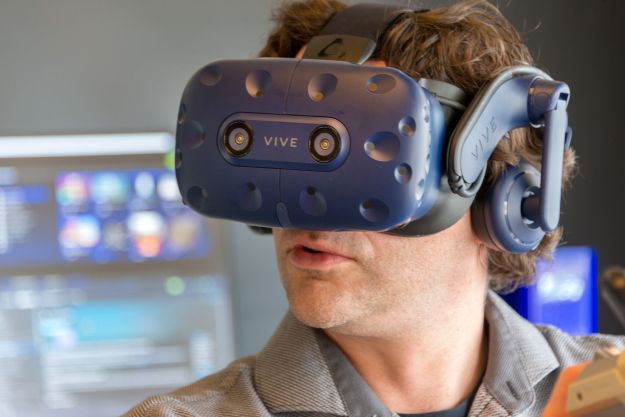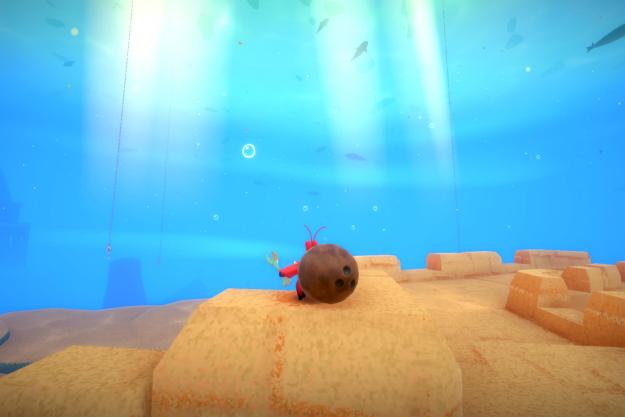Chroma – the upcoming free-to-play first-person shooter from Harmonix and Hidden Path Entertainment that takes its name from the Greek word for color – lies at the sensory intersection between light and sound. Yes, the studio that dreamed up Rock Band is building a first-person shooter, with some help from Hidden Path Entertainment, the team behind Counter-Strike: Global Offensive. It’s a class-based competitive action game with a musical twist. Weapons are built on the foundation of rhythm mechanics. Pulsing electronic beats swap time signatures and melodies as the balance of power shifts in each match. The screen is awash with color at all times, and it’s the rhythmic thump of the all-consuming neon glow that serves as your guidepost through a hostile musical landscape.
It’s very rough and subject to change in its current pre-alpha state, but you’ve definitely never played anything like Chroma before.
Story/Concept
And the beat goes on. The fictional basis for Chroma continues to take shape as the game becomes more fleshed out, but there’s a high-concept idea at the heart of it all: a rhythm-based multiplayer arena shooter. Everything from how weapons are fired to the physical makeup of a given map is at the mercy of the beat. You’re not fighting alongside squadmates; they’re bandmates. You’re making war with music. The goal for Harmonix and Hidden Path is to deliver gameplay that offers accessibility to fans of both shooters and rhythm games, while also encouraging each camp to embrace aspects of the other. All of this makes much more sense once you understand how the play actually works (see Gameplay, below). From a conceptual standpoint, the important thing to understand here is Harmonix’s goal of delivering a multiplayer shooter that marries rhythm-based mechanics with the progression-driven sensibilities of the modern online FPS.

New business opportunities. For Harmonix, Chroma also represents a shift in the company’s way of doing things. This is a free-to-play, Windows-only game that will be released via Steam. The intent is to bring players in early and shape the game around their feedback. A proper alpha is set to kick off in February 2014, with a wider public beta opening up later in the year. This “early access” approach caters specifically to the creative experimentation that Harmonix embraces. Only instead of releasing a finished game with all its parts in place, for better and for worse, the studio is letting players in during an early phase of the development process, in the hopes of better fine-tuning the experience for its target audience.
Gameplay
Getting the band back together. There are currently five different classes in Chroma, each one equipped with weapons that embrace rhythm differently. Each class fits into a basic shooter archetype – assault, engineer, sneak, support, and tank – but their differing rhythm mechanics intentionally cater to different play styles. Some weapons cater to more rhythmic play while others operate like you’d expect them to in a traditional multiplayer FPS. The beat for all rhythm-based mechanics is set by the music playing behind each match. We’ll look at each of the classes as they exist right now, but you can expect a lot of this to change as the alpha and beta phases bring feedback.
- Assault: This is Chroma‘s welcome mat for rhythm-less shooter freaks. Its primary weapon, a full-auto SMG, feels just like similar firearms from other games. You shoot at whatever, whenever, with no reliance on the music. Assault’s secondary weapon is a grenade launcher with an explosive projectile that explodes on the downbeat of whatever music is playing. The weapon’s animated aiming reticle – in which a scrolling graphic lines up with a copy of itself on each downbeat – doubles as a visual indicator of when the grenade will explode. This is true for most of Chroma‘s rhythm-based mechanics; there’s always some sort of on-screen visual to help you keep the beat.
- Engineer: The most rhythm-centric of the five classes. The engineer dual-wields a pair of pistols, which have an aiming reticle that looks like a reversed two-lane note highway, a la Rock Band. You click the left and right mouse buttons in time with each “note” as it scrolls up to the target area in the center of your screen; click at the wrong time, and the weapon won’t fire. While the in-game music changes several times over the course of a match, each section is built on a simple rhythm that is mirrored in the dual pistols’ beat pattern. The weapon also auto-targets, making it much easier to fire while moving once you’ve learned the beat. The engineer’s secondary weapon is a shotgun that must also be fired on the beat; it doesn’t auto-target like the pistols do, but its spread is devastating at close range.

- Sneak: This is a fast-moving sniper class. Your primary weapon is a scoped sniper rifle that delivers significantly increased damage when you fire on the downbeat. A meter that circles the targeting area when you’re in scoped view fills up in time with the music. You need to fire when the meter is filled for the most damage. This creates an unusual push-and-pull when lining up shots; do you go for the more damaging killshot on the downbeat or do you take the shot the moment you’ve got it lined up, even though it’ll do less damage? The sneak also carries a “Streak Pistol” that builds up a damage multiplier as you continue firing repeatedly on the beat.
- Support: The only non-combat-focused class, support carries a beam “weapon” that heals allies and wraps them in a protective shield when you keep the beam on them. Support’s secondary is also beam-based, though it’s an offensive weapon that inflicts damage slowly for as long as you can sustain fire on your target.
- Tank: The slowest-moving class of the five. Primary weapon is a rocket launcher that can be used in a couple of different ways. The basic dumb-fire version of the rocket travels in a straight line until it comes into contact with something, though you can also detonate it in flight using the secondary fire button. If you wait before firing until the launcher locks on, however, you can fire a heat-seeking projectile instead that follows its target as long as you keep clicking the fire button to the beat of the music. The tank’s secondary weapon is a shotgun that can only be fired on half notes. With both of these weapons, the pulsing of colors on the screen help you to keep your clicks on the beat. Of the five classes, the tank is also the most middle-of-the-road in terms of striking a balance between traditional first-person shooting and rhythm-based play.
Playing music or making war? Maps in Chroma will adjust over the course of a given match as the in-game music shifts into new melodies. These “Change Up” moments, as they’re called, see the map physically transform. Electrified water may flood a previously dry area, making it temporarily impossible to reach a previously accessible control point. Towers might spring up, creating sniper roosts where there was just flat landscape before. Learning is a key part of Chroma. The music and any related Change Ups are fixed for each map. In the same way that you need to become familiar with the beat to get the most out of certain combat classes, you’ll also need to know when musical changes are coming and how the map will shift in order to capitalize on any strategic benefits that the reformed terrain offers.

The two match types we got to sample were both built on the premise of taking capture points (“Signals,” as they’re officially referred to). One played like a typical game of Domination (a la Call of Duty) or Conquest (a la Battlefield), with the two teams vying to swing control of multiple capture locations over to their side. The other had a more tug-of-war feel, with teams fighting over a rotating set of control points. In truth, we didn’t spend enough time with Chroma to get a good feel for how that latter game type works. This is an extremely chaotic and difficult-to-process game when you first step into it.
Presentation
The legacy of Tron. Chroma‘s shifting, neon-lined terrain and pulsing techno beats compare easily to Tron. The non-final character models only reinforce that; they’re humanoid constructs that shimmer with the color of their team (red or blue). While the basic rhythms remain the same on a given map, the sound of the actual music changes depending on a variety of factors: which team is winning, how close you are to friendly or enemy combatants, even which class/weapon you’re using. The specifics of how Harmonix intends to generate income from Chroma remain unclear, but we’re told that it will relate to how you choose to customize the look and musical “personality” of your beat-tapping warriors.
Takeaway
It’s important to stress once again that Chroma is at a very early stage of development. Harmonix is barely months into the process of building this game. Our time with what’s working at this point was meant to function as a proof-of-concept presentation. The concept is definitely there. We’ve never seen anything like Chroma before. It’s going to need some significant adjustments, covering everything from the way classes support one another to the basic feel of the controls, and a whole lot more polish on top of that, but the core idea is refreshingly original and we’re excited to see it evolve from here.
Sign up for the alpha now at PlayChroma.com.


